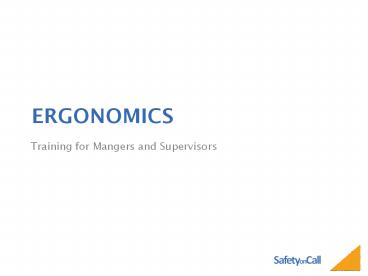ergonomics - PowerPoint PPT Presentation
Title:
ergonomics
Description:
Ergonomics uses knowledge of physical abilities, ... Vibration. Excessive vibration ... Poorly lighted areas also contributes to trip & fall hazards & poor ... – PowerPoint PPT presentation
Number of Views:146
Avg rating:3.0/5.0
Title: ergonomics
1
ergonomics
- Training for Mangers and Supervisors
2
What is Ergonomics
- The science of fitting jobs to people.
- Ergonomics uses knowledge of physical abilities,
limitations human characteristics that apply to
job design.
3
Ergonomic Design
- Considers the tasks, equipment environment to
provide efficient use of worker capabilities
while ensuring that job demands do not exceed
those capabilities
4
Why ergonomics?
5
Proper ergonomics can
- Improve Efficiency
- Increase Production Capability
- Reduce Workplace Injuries
- Lower Workers Comp Costs
- Reduce Absenteeism
6
Muscular skeletal disorders
7
Muscular Skeletal Disorders
- Musculoskeletal disorders (MSDs) are an injury or
illness to soft body tissue such as - Muscles
- Nerves
- Tendons
- Ligaments
- Joints
- Cartilage
- Spinal Discs
8
Muscular Skeletal Disorders include
- Strains Sprains
- Soreness or Pain
- Carpal tunnel syndrome
- Connective tissue disorders
9
Muscular Skeletal Disorders
- MSDs are medical conditions that develop
gradually over a period of time. - MSDs do not typically result from a single
instantaneous event.
10
Causes of Muscular Skeletal Disorders
- Bending
- Climbing
- Crawling
- Reaching
- Twisting
- Overexertion
- Repetitive Exposure
- Standing
11
Risk factors
12
Risk Factors
- Risk Factors are the elements of workstation
design or employee action that can result in
Muscular-Skeletal Disorders. - Environmental Factors
- Activity Factors
13
Environment Risk Factors
- Heat or cold
- Lighting
- Vibration
- Tool design
- Noise
14
Activity Risk Factors
- Static or awkward postures
- Improper gripping
- Improper lifting
- Repetitive Motion
15
Heat Cold
- Heat effects
- Blood circulation
- Causes cramps, burns, rashes and general
discomfort. - Cold effects
- The body's blood circulation
- Causes hypothermia, loss of flexibility,
distraction and poor dexterity. - Comfortable temperature range
- 68 to 74 degrees
- Humidity 20 60
16
Vibration
- Excessive vibration causes pain to muscles,
joints and internal organs. - Soft tissue trauma to the hands, arms, feet and
legs.
17
Lighting
- Under over lighted areas causes
- Headaches
- Muscle strains
- Fatigue
- Eye strain
- Poorly lighted areas also contributes to trip
fall hazards poor coordination.
18
Tool design
- Handle shape
- Control type
- Control location
- Vibration
- Impact
- Pressure
19
Noise
- Noise peaks above 100 decibels cause
- Headaches
- Increased blood pressure
- Muscle tension fatigue
- Irritability distraction
20
Force Exertion
- Forceful exertions place higher loads on the
muscles, tendons, ligaments, and joints. - Factors
- Weight
- Bulkiness
- Speed
21
Posture
- Prolonged standing - varicose veins, back stress,
pooling of blood in legs. - Sitting without back support - low back stress.
- Seat too high - decreased circulation, (legs
dangling over end) bruises.
22
Posture
- Shoulders rounded - Upper/lower back stress,
respiratory distress. - Leaning forward - Lower back stress.
- Arms extended or over-reaching - Stress to arm
muscles, upper back stress.
23
Posture
- Elbows "winged" - Joint stress at shoulder, poor
use of bicep muscles. - Stepping backwards - Loss of balance, displaced
gravity, muscle stress. - Locking knees - Stress to back of knee, poor
blood circulation - Bent Wrist excessive force when gripping.
24
Repetition
- Frequent prolonged repetition of the same
movements cause muscle fatigue and stress. - Factors that increase repetition hazards
- Number of cycles per minute.
- Force required.
- Posture
25
Gripping
- Factors that increase gripping hazards
- Bent wrist
- Surface area
- Surface friction
- Vibration
- Type of grip
26
Lifting
- Factors that increase lifting hazards
- Weight
- Size
- Repetition
- Twisting
- Bending
- Reaching
- Method
27
Control measurers
28
Hazard Controls
- Engineering Controls
- Administrative Controls
- Work Practice Controls
29
Engineering Controls
- Re-design of work station
- Re-design of tools
- Lighting modification
- Vibration control
- Noise Control
- Automation
- Mechanical Lifting
- Material Flow
30
Administrative Controls
- Employee rotation.
- Job task enlargement.
- Adjustment of work pace.
- Redesign of work methods.
- Alternative tasks.
- Rest breaks.
31
Work Practice Controls
- Work techniques procedures.
- Conditioning period.
- Training Lifting techniques.
- Personal Protective Equipment.
32
Analysis tools
33
Checklists
- Basic Screening Tool
- General Risk Analysis
- Computer Work Stations
- Hand Tool Analysis
- Hazard Identification
- Task Analysis
- Workstation Evaluation
34
Program elements
35
Program Elements
- Management Leadership
- Employee Participation
- Hazard Identification
- Hazard Information
- Medical Management
- Program Evaluation
- Recordkeeping
36
Management Leadership
- Assign responsibilities.
- Provide authority, resources information.
- Examine existing policies.
- Take action to correct problems.
- Communicate regularly with employees.
37
Hazard Identification
- Reports of signs, symptoms hazards.
- Recommendations from employees supervisors.
- Records review of existing safety health
records. - Routine facility safety health inspections.
38
Information Training
- Signs symptoms.
- Importance of early reporting.
- Specific hazards controls.
- Reporting MSDs hazards.
- How to recommend control methods.
- Protective Measures.
- Ergonomics program their role.
- OSHA standard requirements.
39
Employee Involvement
- Report of signs, symptoms hazards.
- Hazard control recommendations.
- Access to information.
40
MSD Management
- Prompt response.
- Work restrictions or other measures.
- Prompt access to a health care professional.
- Written Medical Opinion.
- Medical Follow-up.
41
Program Evaluation
- MSD records
- Engineering Controls
- Administrative Controls
- Work Practice Controls
- Opinions
42
Recordkeeping
- Reports of MSD or hazards.
- Responses to employee reports.
- Job hazard analysis.
- Hazard control records.
- Ergonomics program evaluation.
- MSD management records.

